![]()
![]()
![]()
Use LEFT and RIGHT arrow keys to navigate between flashcards;
Use UP and DOWN arrow keys to flip the card;
H to show hint;
A reads text to speech;
61 Cards in this Set
- Front
- Back
|
Define Economic Growth |
The increase in the output (goods and services) of an economy over time. Sustained economic growth should lead to higher real living standards and greater employment |
|
|
What are the 5 main measures of economic growth? |
Nominal/Total GDP GDP per capita Real GDP Potential GDP GNI |
|
|
Define Nominal/Total GDP |
The total market value of all goods and services produced in the country in a given year. GDP can be measured by either adding up all the income early in a country or all of the expenditure. GDP does not include earnings while outside of the country. |
|
|
Define GDP per capita |
The average level of GDP per person |
|
|
Define Real GDP |
GDP adjusting for inflation. E.g. Total GDP may have risen by 4% but if inflation was 3% then Real GDP only rose by 1% |
|
|
Define Potential GDP |
The total potential output of an economy during a period of time |
|
|
Define GNI |
Gross National Income is the final value of income creates by a country’s factors of production whenever they are based. Calculated by GDP plus net income from abroad. (Net income is any income earned by a country on investments and other assets owned abroad minus any income earned by foreigners on investments domestically) |
|
|
Define GNP |
Gross National Product is the total output of citizens of a country where or lot they’re a resident in that country. |
|
|
What are the two methods of measuring national income/output? |
Value: where the value is calculated in (£billions) of all the goods and services produced in a year OR Volume: adding up the quantity of goods and services produced in a year. |
|
|
What will happen to Exports in a boom/recession? |
Boom: Exports will decrease (they’re more expensive) Recession: Exports will increase |
|
|
What will happen to Imports in a boom/recession? |
Boom: Imports will increase (people have more money to spend on imports) Recession: Imports will decrease |
|
|
What are the two ways to show the economic cycle on a diagram? |
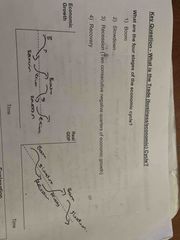
Back (Definition) Economic Growth against time (Trend is a straight line) Real GDP against time (Trend is a diagonal) |
|
|
What will happen to Taxation Revenue in a boom/recession? |
Boom: Taxation Revenue will increase Recession: Taxation Revenue will decrease |
|
|
What will happen to Interest Rates in a boom/recession? |
Boom: Interest Rates will increase Recession: Interest Rates will decrease |
|
|
What is the government target for economic growth? |
2-3% of sustainable growth to avoid inflation. |
|
|
What are the four stages of the economic cycle? |
Boom Slowdown Recession Recovery |
|
|
What are the two ways to show the economic cycle on a diagram? What do the dotted lines show? |
Dotted lines show trend growth |
|
|
Define a recession |
Two consecutive negative quarters of economic growth |
|
|
What will happen to economic growth in a boom/recession? |
Boom: Economic Growth will increase Recession: Economic Growth will decrease |
|
|
What will happen to consumption in a boom/recession? |
Boom: Consumption will increase Recession: Consumption will decrease |
|
|
What will happen to investment in a boom/recession? |
Boom: Investment will increase Recession: Investement will decrease |
|
|
What will happen to inflation in a boom/recession? |
Boom: Inflation will increase Recession: Inflation will decrease |
|
|
What will happen to Unemployment in a boom/recession? |
Boom: Unemployment will decrease Recession: Unemployment will increase |
|
|
What was the Great Depression? |
The Great Depression was a severe worldwide depression. set off by the Wall Street Crash of 1929 when there was a sharp fall in share prices on the New York Stock Exchange. Though it started in America it affected the whole world during the 1930s |
|
|
What are 4 possible causes of the Great Depression? |
●Loss of consumer and business confidence ●Banks over-lending leading to an unstable boom ● Protectionism which reduced world trade which decreased AD and lowered confidence. ● Gold Standard commitment affected the U.K. Left in 1914 rejoined in 1925 at 1914 rate. Though Pound had fallen in value, Gold Standard made it appreciate rapidly rapidly making exports expensive. Entered Depression with overvalued exchange rate.
|
|
|
How did the UK respond to the Great Depression? (4 main areas) |
●Believed that balancing government budget was key to recovery. Borrowed money would prevent private sector. Emergency budget introduced which cut public sector wages and unemployment benefit by 10% and raised income tax from 22.5% to 25%. This reduced AD at a time when it needed to be increased. ● Needed to protect pound so they weren’t forced out of Gold Standard. A balanced budget meant the UK didn’t have to borrow from abroad, which helped the exchange rate as did the high interest rates used to defend the high exchange rate. However, the high interest rates also decreased demand. ● The UK was forced to leave the gold standard on 21 September 1931 due tocontinued speculation against it. This caused the value of the pound to fall by 25% compared to other currencies and allowed the Bank of England to cut interest rates by 2.5%, both of which helped the increase AD by increasing exports or increasing consumption/investment. ● There was recovery in London and the South East but Wales, the north and Scotland did not reach full employment until 1941. |
|
|
How did the USA respond to the Great Depression? |
The US government originally had the same view over a balanced budget as the UK. ● However, Franklin Roosevelt was elected in 1932 with his New Deal which promised public sector investment, work schemes for the unemployed and fiscal stimulus. ● The USA reached full employment in 1943 (two years after joining the war- the same as Britain). Roosevelt’s New Deal is an example of Keynesian expansionary fiscal policy but can be argued it was not large enough to be successful, although it did have a large impact as the US unemployment figure was so high. |
|
|
What was the Global Financial Crisis? |
A severe worldwide crisis in 2008 also started in the US and spread across the world. |
|
|
What were the causes of the Global Financial Crisis? |
●Relatively poor people were encouraged to take out mortgages to buy their own homes. This was an example of moral hazard, as the bank workers saw higher bonuses for selling more mortgages. People could afford the low interest rates on the loan for the first few years, but many were no longer able to continue paying with the higher repayments. Houses were repossessed, demand fell, and prices fell meaning the value of the houses was now less than the mortgage of the house. This is known as negative equity. ● At the same time, banks had been grouping ‘prime’ mortgages (people who were likely to pay back their loans) and ‘sub-prime’ mortgages (those who weren’t) and selling packages to other banks and investors as if they were all prime mortgages. The aim was to reduce risk since it meant no bank was highly dependent on risky mortgages. However, it increased risk as many were now holding assets worth less than they had paid for them; it spread the effects of the housing crash and the unpaid loans. ● When this was revealed, there was a fall in confidence and banks stopped lending between each other, fearing that they would lose money if the other bank were to collapse. Similar events occurred in the UK, Ireland, Spain and Portugal. Northern Rock Building Society was the first affected in the UK in 2007 with too many loans not being repaid, and savers beginning to withdraw their money. In 2008, Lehman Brothers, an investment bank, was allowed to fail. This caused panic as people believed bank after bank would be allowed to collapse, leading to losses for savers. |
|
|
How did both the UK and the US respond to the global fincial crisis? |
Both governments were forced to nationalise banks and building societies and guarantee savers their money in order to prevent the chaos of a collapsed banking system. For example, the British government bought Northern Rock and most of Royal Bank of Scotland and Lloyds Bank. ● They used expansionary monetary policies with record low interest rates and quantitative easing. The Bank of England said the QE led to lower unemployment and higher growth than would otherwise have been the case. ● However, the USA government had a more expansionary fiscal policy and this is perhaps why it recovered faster. E.g. the Obama Recovery and Reinvestment Act. In 2010, the UK prioritised reducing National Debt over providing a fiscal stimulus, but the USA did not make this decision until 2013. |
|
|
What is an output gap? |
An output gap is the difference between the actual level of GDP and theestimated long-term value for GDP- this is shown on the trade cycle diagram whichdemonstrates how the actual GDP is not always on the trend. |
|
|
What's the difference between a positive and a negative output gap? |
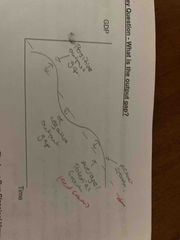
A positive output gap is when GDP is higher than estimated whilst a negativeoutput gap is when GDP is lower than estimated. With a negative output gap, thereis spare capacity in the economy with factories, offices and workers not being utilisedto produce goods and services. Positive Output gaps generally occur during a boom while negative output gaps occur during a recession. |
|
|
How can an output gap be shown on a Keysnian AD/AS diagram? |
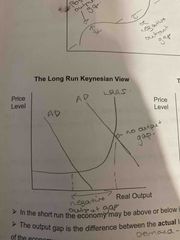
|
|
|
How can an output gap be shown on a Classical AD/AS diagram? |
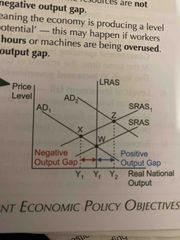
|
|
|
What is the issue with output gaps? |
They are very difficult to measure as the exact position of theLRAS is unknown and also because initial estimates of the real GDP are ofteninaccurate. Some economists believe they are so difficult to measure that they arenot a valid concept to use from the purpose of economic policy. It is notpossible to measure the productive potential of an economy as there is no singlemonetary value for the level of variables such as machinery, workers and technology. |
|
|
What are the implications of a positive output gap? |
Inflation would go up Unemployment would go down Consumption would go up Investment would go up Growth would go up Current Account would go down |
|
|
What are the implications of a negative output gap? |
Inflation would go down Unemployment would go up Consumption would go down Investment would go down Growth would go down Current Account would go up |
|
|
What are the causes of economic growth? Provide some examples |
An increase in quality or quantity of oneof the four factors of production: land, labour, capital or enterprise, or these being usedmore efficiently. ' E.G. Investment Immigration Education/Training Healthcare Participation Rate Technology Productivity Population Etc... |
|
|
What are the two types of growth? |
Actual Growth: is the percentage change in GDP. It is when the economy has actually produced more goods and services. Potential Growth: the change inproductive potential of the economy over time, so the LRAS or PPF curve shifts. |
|
|
What would actual growth and potential growth look like on the PPF? |
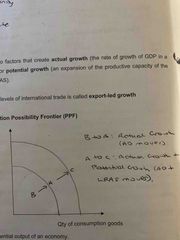
. |
|
|
What's the difference in economic growth and economic recovery? |
An outward shift of the PPFis economic growth. If the economy moves from inside the PPF to on the PPF, thiswould be classed as economic recovery rather than economic growth. |
|
|
Define Productivity |
measure of the efficient use of the factors production |
|
|
Why is productivity important? (Think about economic objectives) |
Lowers inflation, increases economic growth, reduces unemployment, improves current account |
|
|
How is labour productivity most commonly measured? |
output per hour worked |
|
|
What is the productivity gap? What are some examples? |
It is a way of comparing productivity and therefore growth with other countries. Labour productivity is 40% lower than that in the US. The producivity gap with Germany and France is around 20%. British workers would have to work an average 16% more hours to narrow the gap with France and Germany. |
|
|
What causes the productivity gap? |
more skilled labour, differences in technology, regulations, hard work, entrepeneurship (I.E. Factors of production) |
|
|
How could an economy improve its productivity? |
Supply Side Policies More Immigration |
|
|
What are some benefits of economic growth? |
Lowered Unemployment Increased Living Standards New Technology Increased Budget Surplus |
|
|
What are some costs of economic growth? |
Inequality Envrionmental Impact Demand Pull Inflation Leads to deeper recessions Deficit in Balance of payments (People importing more) |
|
|
What is a common way to compare living standards between countries? And why is it used? |
Purchasing Power Parity (PPP) is used. This is because when using GDP per Captia, GNP or GNI per capita with countries that have different currencies, the exchange rate may not reflect their true value. PPP takes into account the cost of living. |
|
|
Explain how Purchasing Power Parity works. Give an example of it being used |
Purchasing Power is the real value of an amount of money in terms of what you can buy with it. (E.g. You can buy more with $1 dollar in Nigeria than you can in Canada) So using PPP involves adjusting GDP per capita figures to take into account the differences in purchasing power. Results are usually expressed in US Dollars' E.G. Big Mac Index is used to compare the cost of the big mac throughout the world. |
|
|
What are 6 limitations to using GDP to make comparisons between countries? What is an alternative? |
An alternative is measuring the development of an economy or happiness as GDP doesn't take into account:
-Hidden Economy (Cash in hand work) -Public Spending ( Some countries have more benefits than others) -Extent of Income Inequality -Envrionment -Wellbeing/Health
-Can also be errors in calculating the inflation rate for real GDP/Transfer payments should be subtracted
|
|
|
What ways are there to measure the development of an economy? |
HDI (Human Development Index) GPI (Genuine Progress Indicator) Number of mobile phones per thousnad of the population Levels of disease/malnutrition Access to clean water Levels of political and social freedom etc. |
|
|
What is HDI? |
Human Development Index was developed by the UN to measure and rank countries' levels of social and economic development. It is a composite statistic of life expectancy, education and income indices. HDI is used to rank countries into four tiers, the higher the ranking the higher the over of development. |
|
|
What is GPI? |
Genuine Progress Indicator attempts to improve GDP by including measures of the impact of economic growth on the environment as well as various social factors. (quality of life, crime, volunteer work, housework, parenting) |
|
|
How can happiness be measured? |
In terms of UK National Wellbeing, the "Measuring National Wellbeing "report was launched in 2010. Contains 4 key questions about life satisfaction, anxiety, happiness andworthwhileness, where people answer on a scale of 0 “not at all” to 10 “completely”.The report is now updated on a quarterly basis, rather than annually |
|
|
What are the advantages and disadvantages of measuring happiness? |
Advantages: Happiness is a fundamental goal for many Takes more into account than income Disadvantages: Subjective Measure-difficult to compare scores Unethical things can make people happy (Sadists) Always subject to change |
|
|
What is the relationship between real income and subjective happiness? |
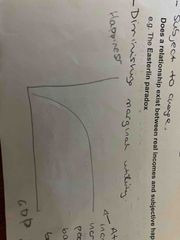
Diminishing Marginal Utility. At low levels of happiness, it increases with income, but at a certain level of income happiness becomes stagnant. |
|
|
What is the Easterlin Paradox? |
Anincrease in consumption of material goods will increase happiness if basic needsaren’t met (shelter and food), but once these needs are met, an increase inconsumption won’t increase long term happiness
|
|
|
How can social status influence the relationship between income and happiness? |
If you are the richest out of everyone you associate yourself with, thenyou will be happier than someone who has the exact same income but is the poorestout of everyone they associate with. Income is linked to social status and highersocial status tends to make us happier. |
|
|
Define Trade Cycle |
The pattern of GDP upturns and downturns |

